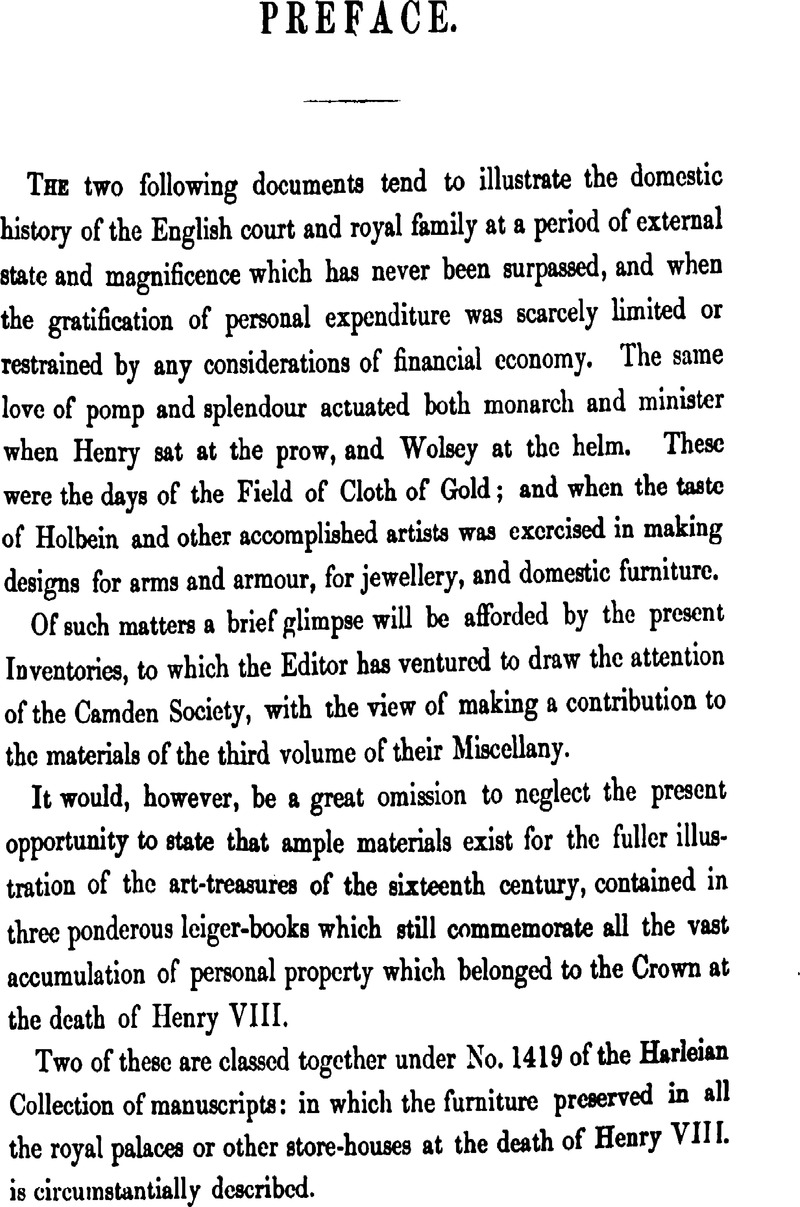No CrossRef data available.
Published online by Cambridge University Press: 25 March 2010

page iv note * Sir N. H. Nicolas, in bis preface to the Privy Pane Expenses of Henry VIII. mentions a fourth corresponding volume called A Book of Arrears of the 14th Henry VIII, 1522-3; but this does not now accompany the others, with which it was probably unconnected. There is, at the Rolls, a volume of that date (14 Hen. VIIL), being a book of Sir Henry Wyat, treasurer of the King's chamber, of money paid into his hands by the treasurers of the several Hhires (A. v. 21).
page v note * From Mr. Craven Ord's sale 1830, lot 1019.
page v note † From Mr, Craven Ord's sale 1829, lot 550. See the Archaeologia, vol. xxiii. p. 340.
page v note † Craven Ord's sale 1829, lot 549, bought by Thorpe. In the sale of 1830 was also, lot 977, Wardrobe at Windsor, temp. Hen. VIII.
page v note § Of a somewhat earlier period is the Privy Purse Book of Queen Elizabeth of York, edited, with a Wardrobe Account of King Edward IV., by Sir N. H. Nicolas, in 1830.
Extract from the Household Book of Edward Stafford, Duke of Buckingham, of the 23 Hen. VII. 1507, were edited by Mr. Gage in the Archaologia, vol. xxv. pp. 311–341.
The Household accounts of the Leatranges of Hunatamon in Norfolk, extending from 1519 to 1578, are published in the aame collection, vol. xxv. pp. 411–669; and those of Lord North, from 1575 to 1579, in vol. xix. pp. 283–301.
Inventories of the property of the Duke of Norfolk and his son the Earl of Surrey, which were seized by the crown in the last year of Henry VIII. are printed in the Appendix to Dr. Nott's Life of Surrey, from documents in H. M. office of Land Revenue.
Of some other domestic inventories of the nobility and gentry I have given a brief catalogue in the Introduction to two “Unton Inventories” which I edited in 1841 for the short-lived Berkshire Aahmolean Society.
For the system of government by which such Urge establishments were maintained reference may be made to the volume of Household Ordinances published by the Society of Antiquaries in 1790, which contains, in pp. 135–260, the Royal Ordinances made at Eltham in 1512, with various supplements added in subsequent yean; to the Northum-berland Household Book, also dated 1512, which was edited by Dr. Percy, Bishop of Dromoro, and reprinted by Pickering in 1827; to the Household Book of the Earl of , Arundel, contained in the Antiquarian Repertory, 1808, vol. ii. pp. 184–209Google Scholar; and to that of Anthony Viscount Montagu, in 1595, recently edited by Sir Sibbald David Scott in the seventh volume of the Sussex Archaeological Collections.
Among the MSS. of the Royal Society, No. 61 contains Orders for the royal household in 9 Hen. VIII.
page vii note * See hereafter, p. xvii., note.
page vii note † Hasted states that the manor of Tong, near Sittingboura, on the death of Cecily duchest of York, 10 Hen. VII., came to the Crown, where it oontinaed till Edward VI. granted it to sir Ralph Fane.—History of Kent, ii. 604. See page lxvii., note.
page vii note † Baynard's Castle, situate on the Thames bank, near St. Paul's Cathedral, was one of the principal mansions in the city of London, and, until the palace of Bridewell was formed by Henry VIII, from the buildings of the monastery of Blackfriare, it probably ranked next in importancetothe Tower ofLondon. Many memorable erents in our national history are connected with its name. During the reigns of Edward IV. and Richard III.
Baynard's Castle was the town bouse of their mother the duchess of York, Soon after the present period it was leased to the Pembroke family; and it was from its walls that the privy councillors opposed to John Dudley, duke of Northumberland, proceeded into Cheapside to terminate the brief reign of Queen Jane, and proclaim the inauguration of that of Queen Mary.
page viii note * The following passage occurs at the close of Miss Strickland's Life of Queen Katharine:—“ The chamber hung with tapestry, in which Katharine of Arragon expired, is to this day shown at Kimbolton Castle; the tapestry covers a little door leading to a closet still called by her name. One of her travelling portmanteaus has remained at Kimbolton ever since her sad removal from Bugden. It is covered with scarlet velvet, and the Queen's initials, K. R. with the regal crown, are conspicuous on the lid; there are two drawers beneath the trunk” Miss Strickland has not made acquaintance with the present Inventory.